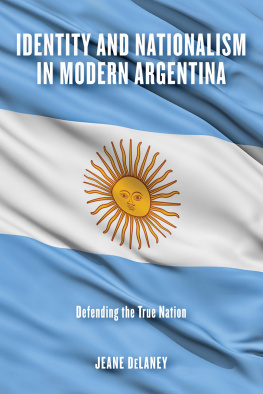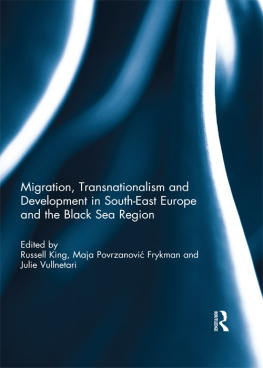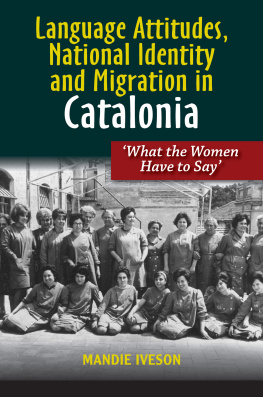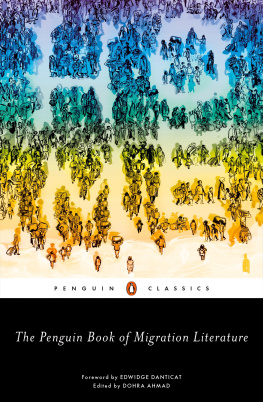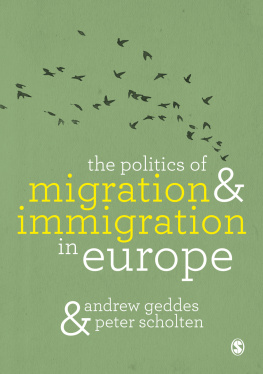National Identity in an Age of Migration
This collection explores, from a variety of angles, the beliefs of citizens and noncitizens about the impact that contemporary migration to the United States is having on American culture and on national solidarity. As in other liberal democracies that have experienced mass migration during the past several decades, there is considerable fear and anxiety in the United States about what newcomers are doing to the nationeconomically, politically, and (especially) culturally. At the symbolic level, Americans largely embrace the idea that theirs is a nation composed of people from many different origins, but recent arrivals put to the test the extent to which the nation is actually prepared to embrace diversity.
The six empirical studies in this volume are divided between those examining how citizens respond to immigrantsincluding right-wing populists, pragmatic multiculturalists, and immigrant advocatesand how immigrants in turn attempt to integrate into the receiving society. This book was originally published as a special issue of the Journal of Intercultural Studies.
Peter Kivisto is the Richard A. Swanson Professor of Social Thought at Augustana College, Rock Island, IL, USA, and the Head of the Research Laboratory on Transnationalism and Migration Processes at St. Petersburg State University, Russia. The author or editor of over 30 books, his most recent book is Solidarity, Justice, and Incorporation (with Giuseppe Sciortino, 2015).
National Identity in an Age
of Migration
The US experience
Edited by
Peter Kivisto
First published 2017
by Routledge
2 Park Square, Milton Park, Abingdon, Oxon, OX14 4RN, UK
and by Routledge
711 Third Avenue, New York, NY 10017, USA
Routledge is an imprint of the Taylor & Francis Group, an informa business
2017 Taylor & Francis
All rights reserved. No part of this book may be reprinted or reproduced or utilised in any form or by any electronic, mechanical, or other means, now known or hereafter invented, including photocopying and recording, or in any information storage or retrieval system, without permission in writing from the publishers.
Trademark notice: Product or corporate names may be trademarks or registered trademarks, and are used only for identification and explanation without intent to infringe.
British Library Cataloguing in Publication Data
A catalogue record for this book is available from the British Library
ISBN 13: 978-1-138-68574-1
Typeset in MinionPro
by diacriTech, Chennai
Publishers Note
The publisher accepts responsibility for any inconsistencies that may have arisen during the conversion of this book from journal articles to book chapters, namely the possible inclusion of journal terminology.
Disclaimer
Every effort has been made to contact copyright holders for their permission to reprint material in this book. The publishers would be grateful to hear from any copyright holder who is not here acknowledged and will undertake to rectify any errors or omissions in future editions of this book.
Contents
Peter Kivisto
Jackie Hogan and Kristin Haltinner
Andrea Voyer
Cawo Abdi
Bernadette Nadya Jaworsky
Elizabeth Aranda, Elizabeth Vaquera and Isabel Sousa-Rodriguez
Christopher Strunk
The chapters in this book were originally published in the Journal of Intercultural Studies, volume 36, issue 5 (October 2015). When citing this material, please use the original page numbering for each article, as follows:
Peter Kivisto
Journal of Intercultural Studies, volume 36, issue 5 (October 2015) pp. 511519
Jackie Hogan and Kristin Haltinner
Journal of Intercultural Studies, volume 36, issue 5 (October 2015) pp. 520543
Andrea Voyer
Journal of Intercultural Studies, volume 36, issue 5 (October 2015) pp. 544563
Cawo Abdi
Journal of Intercultural Studies, volume 36, issue 5 (October 2015) pp. 564578
Bernadette Nadya Jaworsky
Journal of Intercultural Studies, volume 36, issue 5 (October 2015) pp. 579599
Elizabeth Aranda, Elizabeth Vaquera and Isabel Sousa-Rodriguez
Journal of Intercultural Studies, volume 36, issue 5 (October 2015) pp. 600619
Christopher Strunk
Journal of Intercultural Studies, volume 36, issue 5 (October 2015) pp. 620639
For any permission-related enquiries please visit:
http://www.tandfonline.com/page/help/permissions
Peter Kivisto
The six articles that follow in this special issue explore from a variety of angles the impact that contemporary migration to the USA is having, or more to the point, what citizens and noncitizens alike believe it is having, on American culture and national solidarity. The USA is little different from the other worlds liberal democracies that in the second half of the past century became destinations for migrants from the global South and East. In every country that has experienced mass migration during this time, one finds considerable fear and anxiety about what migration is doing to the nation economically, politically, and (especially) culturally. This is the social space within which migrants and their advocates must navigate ways to accommodate to the country of settlement, often while seeking to maintain ties to those left behind in the sending country.
As has become more evident in the present century, in the wake of 9/11 and subsequent terrorist attacks and the intensification of the security state, states are powerful players in this drama a development that the post-nationalist thesis, advanced in the late 1990s, could not have predicted. In Waldingers (2015) recent effort to offer a state-centred theory of the cross-border connection, one that builds on while simultaneously criticising transnational theorists, he stresses the efforts of states to first determine who gets in and who does not and second to cage those permitted entry. By caging he means that states engage in a process of political re-socialisation in which newcomers are expected to embrace the normative expectations of that society and identify with it in the process placing distance between themselves and their homelands (see Kivisto forthcoming for an analysis of this argument). But immigrants are not simply the pawns of state actors. They also act on their own initiative and often seek to prevent the divergence the receiving state demands from occurring with varying levels of success. They also have spokespersons within their ranks and advocates in the receiving society who seek to engage the receiving state and the larger public in an effort to have a voice in determining the terms incorporation.
At a symbolic level, most of the worlds liberal democracies recognise and even appear to embrace the reality of living in a pluralistic society. The USA, for example, has emblazoned on its national seal the words e pluribus unum (usually translated as out of many, one) while the official motto of the European Union (EU) is unity in diversity. The former, which dates to the latter part of the eighteenth century, can be read in two ways: (1) as a description of a nation founded by immigrants, but one in which over time the many gives way to the forging of a national identity predicated on a homogeneous people; or (2) as a nation in which culturally dissimilar people manage to maintain their differences while establishing a transcendent national unity. In other words, it could be read as an endorsement of a homogenising form of assimilation or a multicultural valorisation of difference. In contrast, the EU motto would appear to be explicitly intended to embrace the second of these options. But it need not be read as an endorsement of multiculturalism and as an implicit critique of Fortress Europe, for the diversity in mind may be limited to the national, cultural, and linguistic differences that characterise the 28 member nations, while creating a bright boundary separating Europeans from non-Europeans, particularly those from the global South and East.


